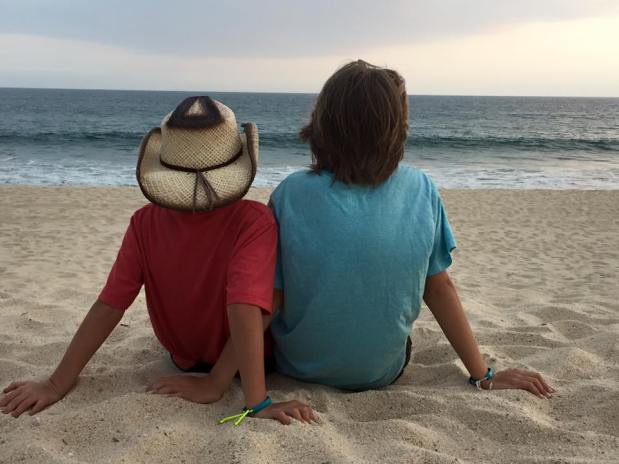“Peace: It does not mean to be in a place where there is no noise, trouble or hard work. It means to be in the midst of those things and still be calm in your heart.”
Author unknown
I am not a quiet person. I like to talk. I like to laugh. Those who know me well describe me as an extrovert. And yet, the older I get, I wonder if that’s really true. I find that as I get older, the more I rely on my inner voice and the more I learn to appreciate silence. When I need to make a big decision I certainly like to talk to others, but ultimately I find I am able to find answers when I am quiet. When I take time to consciously stop and reflect, things become clear. Times like spring break, Christmas break and summer provide natural opportunities to read, reflect, and think. I appreciate these quiet moments and recognize I need to schedule them into my day when life is operating at the regular pace.
 This spring break, I am on vacation with my family in San Jose del Cabo. As I write this blog, I can hear the waves from the Sea of Cortez crashing against the shore. They sound like thunder yet soothe the soul and remind me of the power of the universe. At the shore, the waves are giant as they crash against the sand, yet further out in the distance, the sea appears calm. At the surface, the water churns with emotion, and yet, deep within, a place of calm exists. Listening to the waves, I can’t help but recognize a parallelism that exists between the sea and children. Like the sea, children are full of emotion. The emotions of children are often unpredictable, can change in a moment, and can range from pure jubilation to stormy seas in a matter of moments. Authentic emotions roll freely from children, as they have not yet learned to hide emotion. As parents and educators, we face the challenge of helping children return to a calm place while managing our own emotions at the same time.
This spring break, I am on vacation with my family in San Jose del Cabo. As I write this blog, I can hear the waves from the Sea of Cortez crashing against the shore. They sound like thunder yet soothe the soul and remind me of the power of the universe. At the shore, the waves are giant as they crash against the sand, yet further out in the distance, the sea appears calm. At the surface, the water churns with emotion, and yet, deep within, a place of calm exists. Listening to the waves, I can’t help but recognize a parallelism that exists between the sea and children. Like the sea, children are full of emotion. The emotions of children are often unpredictable, can change in a moment, and can range from pure jubilation to stormy seas in a matter of moments. Authentic emotions roll freely from children, as they have not yet learned to hide emotion. As parents and educators, we face the challenge of helping children return to a calm place while managing our own emotions at the same time.
When I think about the teens I have worked with as an educator, I recognize that so many of them are also like the crashing waves. They have highs, lows, and a range of emotions that surface from positive and negative stressors. It seems more and more common to work with children who struggle with depression, anxiety, or difficulty managing the stress in their lives. As I start to recognize the power of silence, I wonder if we are allowing our children to grow up with enough down time built into their days. Do we help kids find the calm that exists within them? As parents I wonder if we are teaching our kids to appreciate silence or have we created negative associations with quiet time by using strategies such as ‘time out’?
As a parent, there is nothing I want more than my children to grow up ‘happy’. When I say I want my children to be happy, that does not mean that I want to give in to their every wish and surround them with material items. Instead, I want to help them grow up with the habits that truly create happiness. The science of happiness studies the habits of truly happy people. These habits include positive thinking, altruism, exercise, gratitude, connection to others, relaxation, reflection and stress management. So I stop and ask… how many of these habits do we teach to our children? As a parent, I can think of ways I teach my children to think positively, give to others, exercise, connect and show appreciation; but I’m not sure I have put as much effort into teaching my boys how to relax, reflect and manage stress. When I think of our schools, I see the same pattern. Schools today seem busier than when we were kids. Emphasis on cooperative learning and the integration of technology has a positive impact but also adds a new level of connection. This is an exciting time, and learning today is an incredibly rich process. As classrooms become more dynamic, do we need to be consciously aware of the quiet time we schedule into the day? Should we ask ourselves how we are teaching our students to relax, reflect and manage their stress? Kids today grow up with high tech toys, the internet at their fingertips and activity filled schedules. Do we allow for introverted children to shine? Do we teach extroverts the power of silence? Many schools have implemented MindUP training to help children develop mindfulness but unfortunately it seems to be a program of choice based on the teacher rather than a competency that children of all ages are working towards.
 During spring break I am able to spend fun filled days with my kids from morning until evening. Our days are full of swimming, beach walks, activities, games, time with friends, and constant conversation. Our kids have a rich and wonderful life. However, we don’t seem to have much down time built into the day. Even ‘down time’ often involves the TV or a high tech toy.
During spring break I am able to spend fun filled days with my kids from morning until evening. Our days are full of swimming, beach walks, activities, games, time with friends, and constant conversation. Our kids have a rich and wonderful life. However, we don’t seem to have much down time built into the day. Even ‘down time’ often involves the TV or a high tech toy.
The more I read about wellness and happiness, the more I recognize the importance of silence in our daily routines. Silence can take many forms (meditation, mindfulness, yoga, reflection, journaling, etc). Just last night I watched a video clip where Marci Shimoff speaks about happiness and how it was managed in indigenous cultures. When someone was feeling depressed, they would visit the Medicine Man or Shaman. He would ask four questions:
When did you stop moving?
When did you stop singing?
When did you stop telling others your story?
When did you stop having time for silence everyday?
Just last week, my two boys had an argument. As I was getting ready for school my youngest son, age 5, was at my leg crying. He had been first to the remote control yet his brother, age 8, came along and took the remote to turn the TV to his chosen show. Through tears, Cole said “I was watching the Black Show and Jaden changed the channel and the Black Show is my favourite!” I asked Jaden why he had changed the channel, only to discover that Jaden had taken the remote because Cole had not turned the TV on. His favourite show, The Black Show, meant he was holding the remote and staring at the black screen. In the moment this seemed cute and funny. Today, reflecting on life at a busy pace I wonder if I missed a moment for Cole to enjoy the silence.
Like the crashing waves, we have emotion that rolls from us throughout the day, yet like the sea, a place exists within us where we are calm. How can we teach our children to find the calm beneath the waves? When spring break concludes and we return to the hectic pace of regular life, I hope to make moments of silence a routine for my children and I. And next time my five year old grips the remote and asks if he can watch the Black Show, the answer will be a definite yes.
Happy Spring Break!



 I have spent three of the last four weeks in Mexico. On our last day here in the sun, I realize that this is likely the first and last time (until possibly retirement) where I will have the opportunity to relax this much mid-year. For the first week, I was invited to participate in
I have spent three of the last four weeks in Mexico. On our last day here in the sun, I realize that this is likely the first and last time (until possibly retirement) where I will have the opportunity to relax this much mid-year. For the first week, I was invited to participate in 





